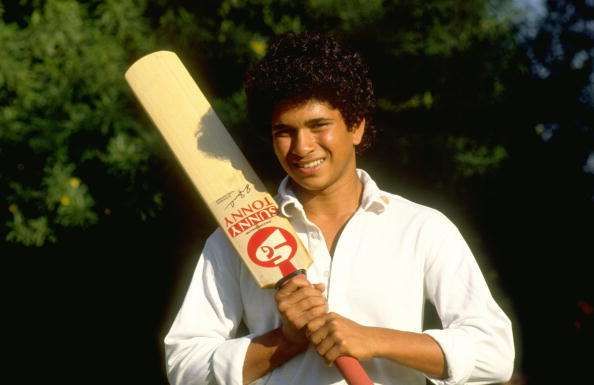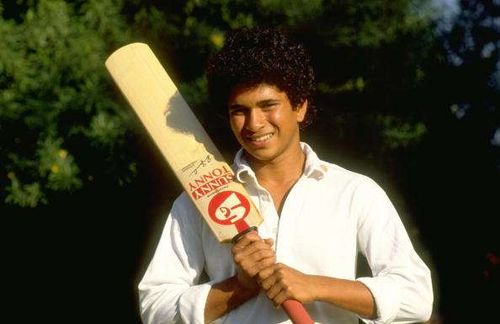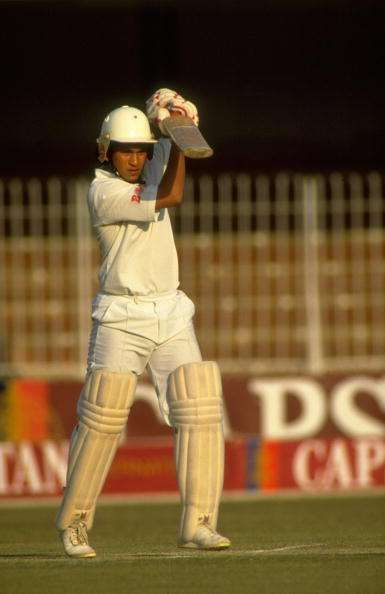
Remembering Sachin Tendulkar's maiden first class century

11th December 1988 witnessed an incident which would become the norm in Indian cricket for the next two decades or so. The young and the old had gathered at the Wankhede stadium, Bombay (now Mumbai) not just to watch a Ranji match but they were here to witness the batting of a 15-year-old Sachin Ramesh Tendulkar who was making his first-class debut.
The spectators had some big names in Indian cricket like Sunil Gavaskar, Raj Singh Dungarpur & Vasu Paranjape (coach of the Indian team in the 1987 World Cup) among others.
“And for once, they wanted a Bombay wicket to fall”
It was the second day of the three-day match between Bombay & Gujarat. Bombay who had bowled out Gujarat for 140 runs, had notched up 95 runs for the loss of one wicket on the previous day. On the next morning, the two overnight Bombay batsmen - Lalchand Rajput & Alan Sippy resumed proceedings; but the spectators were not interested in their batting.
As Sachin Tendulkar's brother Ajit Tendulkar (who played a great role in shaping up Sachin’s career) had put it in his book - “The Making of a Cricketer”, “And for once, they wanted a Bombay wicket to fall. Rather unfairly, they even booed a Gujarat fielder for dropping a catch.”
Also Read: 5 Indian batsmen for whom Wankhede was a happy hunting ground
Just before lunch on that historic Sunday afternoon, the moment for which everybody was waiting for came. Rajput was unfortunately run out for 99, which meant that Sachin would walk into bat. Suddenly, there was a buzz in the Wankhede stadium, some of his Sahitya Sahawas (where Sachin used to then live) friends who had come to watch their friend bat shouted, “Come on Sachu”.
Ask about that cheer to any of India’s opening batsmen and number three of the 1990s & 2000s who had to hear this every time they were the second Indian wicket to fall and you will understand what Rajput would have gone through.
The moment that everyone had been waiting for
Sachin’s turn to face a delivery came seven balls since he had walked in to the centre. “He takes his guard, taps the wicket a bit, observes the field setting, does some on-the-spot running to loosen up and is ready to face his first ball in top class cricket”, reminisces Ajit in his book. He of course still remembers every moment of that debut.
“Good shot Sachu”

Sachin defended the first couple of deliveries and then launched a drive on the third delivery which was slightly tossed up. The ball ran through the covers to the boundary and Sachin had opened his account in first-class cricket. “Good shot Sachu”, his friends screamed.
Post-lunch Sachin got into his own groove, displaying his repertoire of strokes. Soon he moved into the 80s. Then couple of wickets fell on the other end but Sachin was unperturbed. With his score at 95, left arm spinner Bharat Mistry came onto bowl and tempted Sachin with a flighted delivery.
Sachin stepped out and drove through the covers for a boundary. The knowledgeable spectators of the Wankhede had declared this to be “The best stroke of his innings”.
And the century..
With Sachin just a run short of a century on Ranji debut, the Gujarat skipper tightened the field. As Sachin took a single by a turn of the wrists towards backward square leg, the entire Wankhede erupted in joy; definitely not for the last time for Sachin.
Sachin had scored a century on his Ranji debut and thus had become the youngest to score a century on debut in Ranji Trophy. His 100 runs had come off 129 balls with the help of 12 fours.
Coming back to the match, Bombay declared at 394 runs for the loss of 6 wickets and Sachin remained unbeaten on 100. In reply, Gujarat were bundled out for 306 runs leaving the Bombay team to score 53 runs. In the remaining seven overs, Bombay scored 43 runs for the loss of 2 wickets and fell short of the target by 10 runs.
So, the match had ended in a draw; but it had signalled the arrival of a cricketer who would go on to become one of the greatest batsmen of all time.
He had made his intentions clear on that day itself and it was reinforced the next year when in his quirky voice he had said “Main Khelega” (I will play) after being hit by a Waqar Younis bouncer against Pakistan in Sialkot. Over the years to come and till the time the great man from the western suburbs of Bombay hung up his boots; be it the Wankhede or the Sydney Cricket Ground, the words “Saachin Saachin” became synonymous with Indian cricket.
Incidentally, exactly 16 years since that Ranji debut; on 11th December 2004, Sachin equalled Sunil Gavaskar’s record of 34 test centuries versus Bangladesh at Dhaka.
Now, given the fact that Sachin ended up scoring a century of centuries, these two centuries may not rank up as his best knocks; but nevertheless, they were two significant milestones in a remarkable career. And as Sachin had himself said in January 1989 in an interview to Tom Alters, “This is the start”.